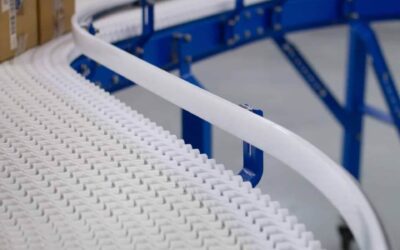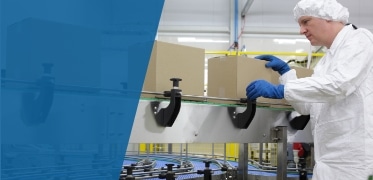The phrase “lean manufacturing” has become quite buzzworthy these days, and it certainly deserves the attention. This popular technique is changing the way many companies like the Toyota Motor Corporation operate and create their products. But what is lean manufacturing and how can it benefit your facility? This expert guide will examine the fundamentals of this process and provide some warehouse improvement ideas you can start implementing today.
What is Lean Manufacturing?
Lean manufacturing is the systematic reduction of waste in a business’s manufacturing process. To determine what is defined as “waste,” a company will take a closer look at the procedures it executes to create its products. Those procedures are categorized in one of two ways: value-added components or non-value-added components.
A value-added component is an action or expense that directly leads to products or services for which a customer is willing to pay. For example, if a car company were to paint a car blue during the manufacturing process, a customer would be willing to pay for this effort. Therefore, it is something deemed as adding value.
In comparison, non-value-added components are actions or expenses during the manufacturing process for which customers would not be willing to pay. An example of this is the cost of shipping the car from the country where it was built to the country where it will be sold.
These two categories help manufacturers decide which procedures require lean process improvement. A value-added component can typically remain as it is, while something deemed as not adding value is seen as producing waste in warehouse procedures.
Before you conclude your facility can’t use any lean process improvement, think again. According to the Lean Enterprise Research Centre (LERC), up to 60% of production activities in a typical manufacturing operation are determined to be waste. But that doesn’t mean they have to stay that way. When a procedure is referred to as “non-value-added,” there are plenty of opportunities for lean process improvement. Before that can happen, it’s important to examine each non-value-added procedure and label it as one of the eight types of waste found in warehouses.
Waste in Warehouse Problems & Lean Manufacturing Solutions
Each non-value-added component can be categorized as at least one of eight lean manufacturing waste types. Use this section to help you identify which types your warehouse may be experiencing. Then, refer to our warehouse improvement ideas for helpful guidance and solutions.
1. Movement
Of course, some forms of moving are crucial during manufacturing. But moving around becomes a problem when employees have to walk or relocate to retrieve things that could be closer in proximity. Employees experience this when they have to walk to get supplies which could be located closer to the point of use.
Warehouse Improvement Ideas
The phrase “seiton” translates to “straighten”, and it’s one of the main principles of lean manufacturing. It involves creating a proper place for everything your business uses to maximize efficiency.
Your employees have to use certain tools and supplies on a daily basis. Keep those items close by, so they don’t have to travel far to retrieve them. This will ultimately save them time and save you money.
2. Excess Inventory
Dealing with obsolete inventory can present a lot of obstacles. Typically, these items haven’t been sold for a long time and aren’t expected to sell in the foreseeable future.
Warehouse Improvement Ideas
The key here is “seiri” or sorting. You want to separate the necessary items from the unnecessary. Better organization may not get these items out of your warehouse, but it will make the process of locating current inventory faster and easier.
3. Delays
Unfortunately, manufacturing facilities often experience a lag in time when parts they need are missing. This pause in your employees’ work can waste valuable minutes and even hours.
Warehouse Improvement Ideas
The lean manufacturing phrase “Shitsuke” translates to “maintaining consistency and striving for improvement.” In this case, a great way to apply it is by first examining the situation. Take a look at what occurred to cause the delay, and brainstorm ideas to stop it in the future. Then create a new procedure to follow that lessens the chance of the delay happening again.
4. Transport
This entails moving equipment, tools and various materials around when it isn’t necessary.
Warehouse Improvement Ideas
For example, warehouses often use conveyors that wind around a building while transporting a company’s product. Often, transporting items like this is unnecessary and wastes time. Using a specialty conveyor can provide a more direct route to increase efficiency.
5. Overproduction
Creating too many items or the wrong type of item can result in costly mistakes. Overproduction is a less than ideal situation for both the company and the customer.
Warehouse Improvement Ideas
Lean manufacturing stresses continuous improvement. In this situation, you want to look for the cause of overproduction. Did poor communication take place? Was there a lack of organization? It’s helpful to recognize how overproduction has occurred and build a plan around reducing and avoiding in the future.
6. Defects
No one likes a faulty product. Failing to produce a quality part usually results in having to manufacture the item all over again. This means you’ll have to spend more money on something that should have been done right the first time.
Warehouse Improvement Ideas
Aim for automation with a human touch. At the first sign of a problem or defect, stop the manufacturing process. This will prevent more products from being made incorrectly, and it also allows you to assess the situation.
7. Overprocessing
Does the phrase “We’ve always done it this way” sound familiar? If so, your facility is probably a victim of overprocessing.
Warehouse Improvement Ideas
When possible, cut redundant steps out of your manufacturing process. Just because something is tradition doesn’t mean it can’t be improved.
8. Ignoring Employees’ Input and Skills
Many companies focus on the product and forget the people. This results in disgruntled employees and can have a domino effect of negative consequences that hurt your business.
Warehouse Improvement Ideas
One of the biggest values in lean manufacturing is putting people first. Your employees are the heart and soul of your business. In many ways, they’re your most valuable asset. It’s important to utilize their skillsets and get their feedback on the manufacturing procedure. In doing this, you’ll make them feel valued, and your company will be more successful.
Start Lean Manufacturing and Get More Warehouse Improvement Ideas with Span Tech
We realize introducing any new concept into your warehouse is no small feat. For lean process improvement, you need the right guidance and equipment. That’s why Span Tech is here to help. Our top-quality conveyor systems are a great tool to help your business reduce waste in warehouse procedures. For additional information on our products and how to implement lean manufacturing, contact our customer service team today!










